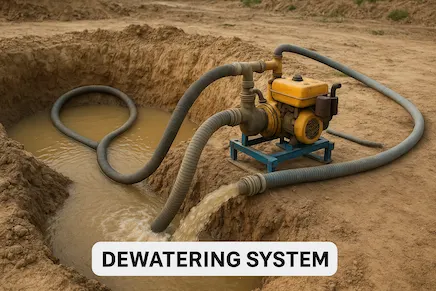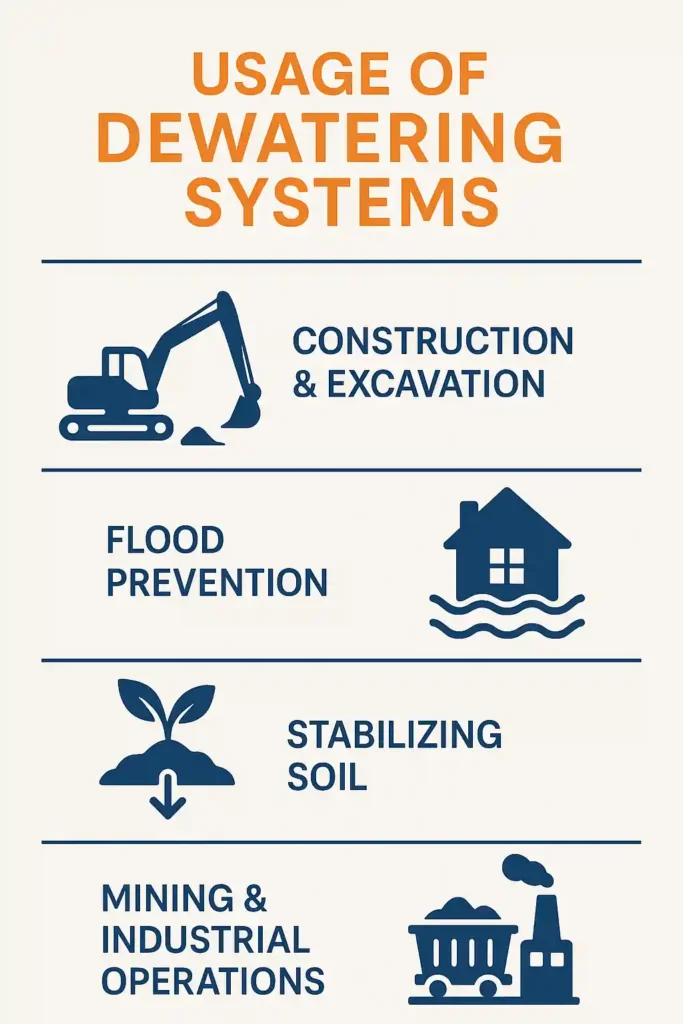Tired of work delays due to waterlogging on sites? Dewatering is your ultimate solution.
However, do you know that there are different types of dewatering systems for various conditions, such as site, soil type, and water level?
Choosing the right dewatering system will not only help you achieve the desired results and get your old ready-to-work site, but also cut the extra cost and time.
This blog will help you understand the types of dewatering systems, their operation, and the optimal conditions for their use.
What is dewatering system?
A dewatering system is a technique or equipment used to remove unwanted water from a construction site, excavation, or industrial area. The primary goal of dewatering is to lower the groundwater level or remove surface water from a specific area, usually to allow for a dry, stable, and safe working environment. This water can be from groundwater, surface water, or other sources. Dewatering process is particularly important in excavations sites, construction sites, basements, tunnels, and underground utilities, where collected water can lead to delays, safety hazards, and structural issues.
Dewatering is crucial to ensure that projects run smoothly without delays, and also to ensure safety and stability in waterlogged environments.

Key Purposes
- Prevent flooding in excavations or trenches
- Increase soil stability for foundation and structural work
- Facilitate underground construction (e.g., basements, tunnels)
- Reduce erosion and water-related delays
How does a dewatering system work?
A dewatering system operates by drawing water out from the soil or excavation area. Here’s a simple breakdown of how it works:
1. Site Assessment:
The first step is to assess the site’s soil and groundwater conditions to determine the best dewatering method.
2. Installation:
Various systems, such as wells, pipes, and sumps, are installed to collect and drain the water from the site.
3. Water Removal:
Using pumps or gravity, water is collected from beneath the surface and transferred to a discharge location. Sometimes, the water is filtered or treated before being discharged.
4. Continuous Operation:
The system works continuously, operating during the excavation process and until the site is ready for construction or has been waterproofed.
Types of Dewatering System
Different dewatering methods are suited to various site conditions and project requirements.
Here are the most common types of dewatering system:
| Dewatering System | Description | Best Suited For |
| Wellpoint System | In this system, small-diameter wells are drilled around the excavation area or site, and then they are connected to a header pipe and a vacuum pump to draw water and lower the water table. | This method is best suited for shallow excavations, sandy or fine soils. |
| Deep Well System | In this process, multiple deep wells are drilled and then connected to submersible pumps to reduce the water. Usually it is used for larger or deeper sites. | It is best for deep excavation or projects with permeable solids. |
| Sump Pumping | In this method, sumps (pits) are dug, where water accumulates, and then pumped out. | It is great for low water levels and shallow excavations. |
| Eductor Wells/ Ejector Wells | These wells use a special process where high-pressure water is forced down a pipe to create a vacuum at the bottom of the well, and then this vacuum pulls groundwater up through the well. | Eductor Wells are best suited for sites with deep, low-permeability soils like clays or silts. |
| Gravity Drainage | As the name suggests, it uses natural ground slopes. Water in the soil naturally flows downhill through trenches, ditches, or pipes that have been put in place around the site. | Gravity drainage is effective at shallow sites with sloped terrain or low groundwater levels. |
| Sand Drains | In this method, vertical columns filled with sand or gravel are installed in soft, water-logged soils. Water in the soil flows easily into these sand columns and then moves downwards. | It is used on the site with soft and compressible soils to bring stabilization. |
| Vacuum Dewatering | In this process, a system is set up to create a vacuum anova on within the soil. This vacuum sucks water out of the ground repidly, usually using pumps and sealed pipes. | This method is used at large sites or areas requiring rapid water removal. |
Usage of Dewatering System

Dewatering system are widely used across various industries and applications, including:
1. Construction & Excavation:
They are used to lower the water table at construction sites before digging foundations, basements, or utility trenches.
2. Flood Prevention:
Dewatering helps prevent water accumulation, particularly in areas that have high groundwater levels or are prone to heavy rainfall.
3. Stabilizing Soil:
Dewatering keeps the soil dry and stable, reducing the risk of soil collapse or erosion during construction.
4. Mining & Industrial Operations:
They are essential for extracting water from mining sites or during water treatment processes where efficient water removal is necessary.
Conclusion
Waterlogging can lead to accidents and work delays; in such cases, dewatering becomes the ultimate savior.
A dewatering system plays a vital role in ensuring construction sites, excavation projects, and mining operations stay safe and dry, and there are no longer delays in work due to waterlogging.
Understanding the different types of dewatering systems and their uses helps you select the best solution for your specific project needs.
Whether you’re managing groundwater in construction or removing water from mining operations, choosing the right dewatering method will ensure that your project proceeds without unnecessary interruptions.
If you’re in need of reliable dewatering solutions in Pune, Raajgad Pumps offers a wide range of high-quality pumps and systems for every need. From submersible pumps to deep well systems, we ensure your dewatering requirements are met with efficiency and reliability.
For more information, visit the https://www.raajgadpump.com and find the perfect system for your project!




